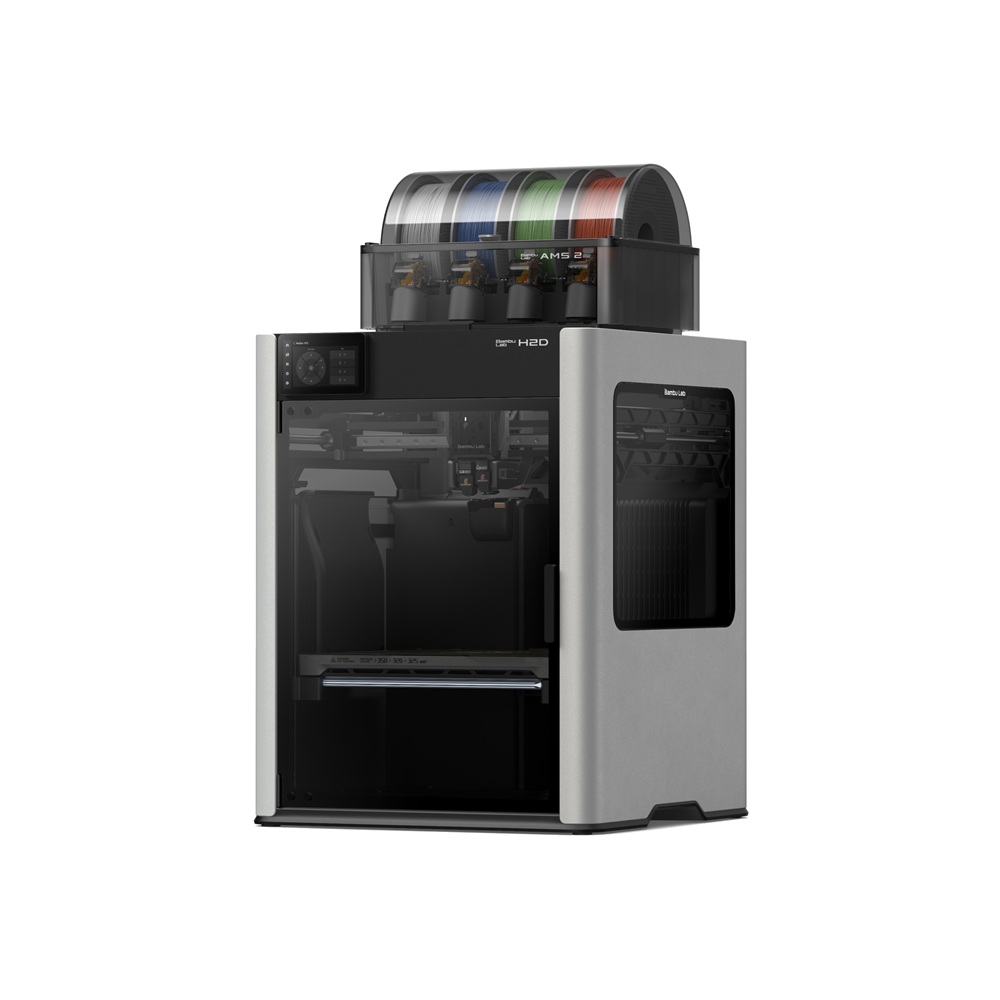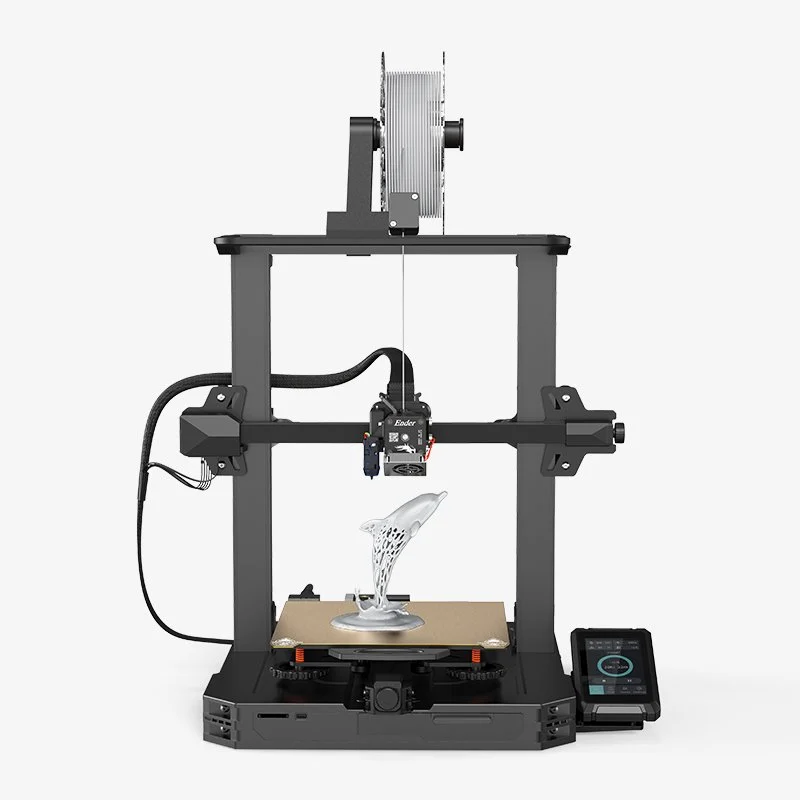Compare H2D vs Ender 3 S1 PRO
Comparison between the best 3D printers
Choose the best 3D printer at the best price. The cheapest 3D printers are here.
Buy a 3D printer here with 3D Fila.
 |
 |
|
| Model | H2D |
Ender 3 S1 PRO[BUY Ender 3 S1 PRO] |
| Printing Material | Filament | Filament |
| Buy Filament for Bambu Lab H2D | Buy Filament forCreality 3D Ender 3 S1 PRO | |
| Estimated price | $1899,00 | $499,00 |
| Manufacturer | Bambu Lab | Creality 3D |
| Release Year | 2025 | 2022 |
| Print Volume [mm] | 350x320x325 | 220x220x270 |
| Printer Size [mm] | 492x514x626 | 450x49x620 |
| Weight [kg] | 42,3 | 8,7kg |
| Power Loss Recovery | YES | YES |
| Enclosed printer | YES | NO |
| Bed Leveling | Automatic | Automatic |
| Filament End Sensor | YES | YES |
| Bed type | Heated | Heated |
| Power supply system | Direct Drive | Direct Drive |
| Standard nozzle | 0,4 | 0,4 |
| Maximum Nozzle Temperature [°C] | 350 | 300 |
| Maximum Bed Temperature [°C] | 120 | 110 |
| Maximum printing speed [mm/s] | 600 | 150 |
| Filament holder | YES | YES |
| Camera for supervision | YES | YES |
| Recommended filaments | PLA, PETG, ABS, ASA, TPU, PVA, Nylon (PA) | PLA, PETG |
| Recommended slicers | Bambu Studio | Cura, Simplify, Slic3r |
| Maximum Resolution [mm] | 0,01 | 0,1 |
| Processor | ||
| Display | Touchscreen 5'' | Display touchscreen 4,3'' |
| Power Supply | 350 | |
| Connectivity | Wifi, Bambu bus, Cartão SD | SD |
| Operating systems | Windows, Mac, Linux | Windows, Mac, Linux |
| Date of registration in the system | 2025-03-31 | 2022-10-11 |
| Release date | 2025 | 2022 |
| Extra features | Bambu Labs H2D combines high-speed 3D printing with a chamber heated up to 65 °C, dual extrusion with automatic nozzle switching, an AMS for filament drying and exchange, and AI sensors that detect failures. It offers optional laser and digital cutting capabilities, features intelligent calibration through computer vision, vibration control, enhanced fire safety, and real-time camera monitoring. | Creality's Ender 3 S1 PRO is an innovation in the Ender 3 series, featuring a Sprite Pro Extruder capable of reaching 300°C and dual lead screws on the Z axis, ensuring greater stability and print quality. Its PEI-coated print bed, combined with CR-Touch automatic leveling, provides excellent adhesion and ease of part removal. The user interface, via a 4.3-inch touchscreen, offers intuitive and efficient control, although it has some limitations regarding the handling of long file names and navigation. The well-designed extruder ensures effective cooling and handling of various filaments, although there may be a slight ghosting effect at high speeds due to its weight. This printer represents a balance between technological advances and operational challenges, remaining faithful to the quality expected of the Ender line. |
| Support for multiple colors and materials (AMS and CFS) | YES | NO |
Notes * |
||
| Cost-benefit | 7 / 10 | 7 / 10 |
| Hardware | 8 / 10 | 2.8 / 10 |
| Tela | . | . |
| Print volume | 4 / 10 | 3 / 10 |
| Performance | 5 / 10 | 1 / 10 |
| [BUY Ender 3 S1 PRO] |
Conclusion |
| In comparing the Bambu Lab H2D and the Creality Ender 3 S1 PRO, several key factors must be considered, including price, features, and overall capabilities. The Bambu Lab H2D, priced at a premium, offers an extensive range of advanced features that cater to professional and high-demand users. With a significantly larger print volume, higher maximum nozzle and bed temperatures, and remarkable printing speeds, it positions itself as a powerhouse in the 3D printing market. The inclusion of features like dual extrusion, real-time monitoring via camera, and intelligent calibration through computer vision make it more suitable for intricate and detailed projects. Furthermore, its enclosed design provides better thermal stability, which is advantageous for printing with various materials, including high-temperature plastics. On the other hand, the Creality Ender 3 S1 PRO, while more budget-friendly, still delivers impressive performance and user-friendliness. It features reliable automatic leveling, a well-designed PEI-coated print bed, and is capable of handling popular materials like PLA and PETG effectively. Although it may lack the expansive amenities of the H2D, it remains a solid choice for hobbyists and those new to 3D printing, ensuring they receive decent print quality without a hefty investment. Ultimately, the decision between these two printers hinges on the user’s specific needs: those seeking advanced technology and higher output capabilities may lean towards the Bambu Lab H2D, while budget-conscious consumers or beginners might find the Creality Ender 3 S1 PRO to be more than adequate for their 3D printing endeavors. Both models uphold a respectable cost-benefit ratio, tailored to their respective target audiences in the 3D printing landscape. |

